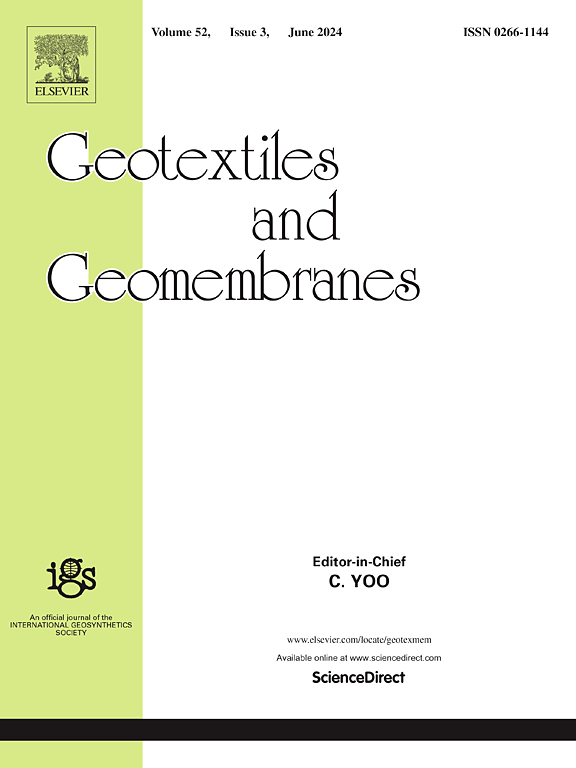Effect of temperature on geogrid-facing connection force and lateral earth pressure based on innovative testing method
IF 6.2
1区 工程技术
Q1 ENGINEERING, GEOLOGICAL
引用次数: 0
Abstract
Conventional geosynthetic-reinforced soil (GRS) retaining wall design guidelines focus on the horizontal reinforcement tensile force calculated based on lateral earth pressure under constant backfill temperature, while giving insufficient attention to the actual connection mechanism between the wall facing and the reinforcement. This limitation may impact the service life of retaining walls. In this study, a novel testing method was developed to simulate the differential settlement between the backfill and the facing within walls, enabling a new approach to quantify the reinforcement-facing connection force under various temperature conditions. Test results demonstrated that this connection force significantly exceeds the measured horizontal reinforcement tensile force under high vertical stress, and the ratio tends to increase with rising temperature under the same vertical stress. Additionally, the lateral earth pressure exerted on the wall back increases with the reinforcement stiffness, but it remains lower than the Rankine active earth pressure. At low temperatures, the conventional estimation method based on Rankine theory was shown to significantly underestimate the actual connection force. The study provides insights for the modification of the current GRS wall design guidelines.
基于创新测试方法的温度对土工格栅连接力和侧土压力的影响
传统的土工合成加筋土挡土墙设计指南侧重于在一定回填温度下,根据侧土压力计算水平钢筋受拉力,而对墙面与钢筋的实际连接机制关注不足。这种限制可能会影响挡土墙的使用寿命。本研究开发了一种新的试验方法来模拟墙内充填体与面板之间的差异沉降,为量化不同温度条件下的配筋面板连接力提供了一种新的方法。试验结果表明,在高竖向应力条件下,该连接力明显大于实测水平钢筋拉伸力,且在相同竖向应力条件下,该比值随温度升高而增大。加筋后墙侧土压力随加筋刚度增大而增大,但仍低于朗肯主动土压力。在低温下,传统的基于朗肯理论的估计方法明显低估了实际连接力。该研究为修改现行的GRS墙体设计指南提供了见解。
本文章由计算机程序翻译,如有差异,请以英文原文为准。
求助全文
约1分钟内获得全文
求助全文
来源期刊

Geotextiles and Geomembranes
地学-地球科学综合
CiteScore
9.50
自引率
21.20%
发文量
111
审稿时长
59 days
期刊介绍:
The range of products and their applications has expanded rapidly over the last decade with geotextiles and geomembranes being specified world wide. This rapid growth is paralleled by a virtual explosion of technology. Current reference books and even manufacturers' sponsored publications tend to date very quickly and the need for a vehicle to bring together and discuss the growing body of technology now available has become evident.
Geotextiles and Geomembranes fills this need and provides a forum for the dissemination of information amongst research workers, designers, users and manufacturers. By providing a growing fund of information the journal increases general awareness, prompts further research and assists in the establishment of international codes and regulations.
 求助内容:
求助内容: 应助结果提醒方式:
应助结果提醒方式:


